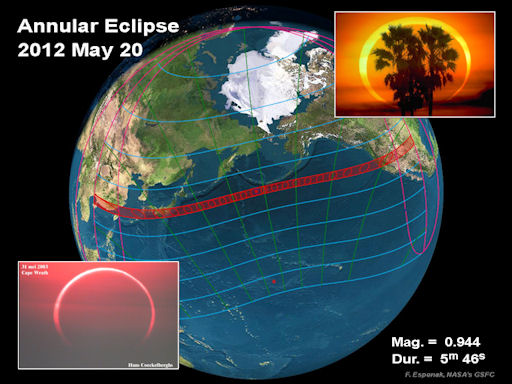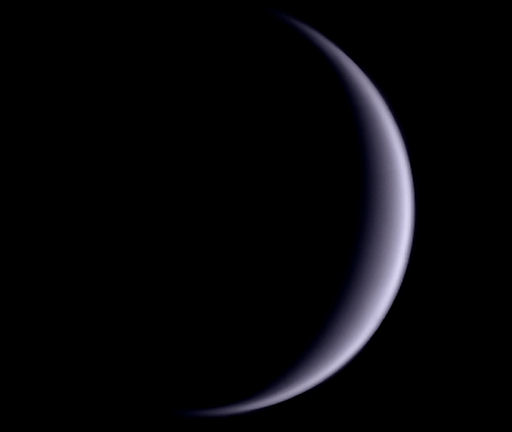INTERPLANETARY
SHOCK WAVE: An interpanetary shock
wave possibly associated with the M5-class
solar flare of May 17th swept past Earth on May
20th around 0200 UT. The shock's arrival caused
geomagnetic activity around the poles, but so far
no reports of high-latitude auroras.
SOLAR
ECLIPSE THIS WEEKEND: On Sunday,
May 20th, the Moon will pass in front of the Sun,
producing an annular solar eclipse visible across
the Pacific side of Earth. The path of annularity,
where the sun will appear to be a "ring of
fire," stretches from China and Japan to the
middle of North America:
An animated
eclipse map prepared by Larry Koehn of ShadowandSubstance.com
shows the best times to look. In the United States,
the eclipse begins at 5:30 pm PDT and lasts for
two hours. Around 6:30 pm PDT, the afternoon sun
will become a luminous ring in places such as Medford,
Oregon; Chico, California; Reno, Nevada; St. George,
Utah; Albuquerque, New Mexico, and Lubbock, Texas.
Outside the narrow center line, the eclipse will
be partial. Observers almost everywhere west of
the Mississippi will see a crescent-shaped sun as
the Moon passes by off-center.
Because this is not a total eclipse,
some portion of the sun will always be exposed.
To prevent eye damage, use eclipse glasses, a safely-filtered
telescope, or a solar
projector to observe the eclipse. You can make
a handy solar projector by criss-crossing your fingers
waffle-style. Rays of light beaming through the
gaps will have the same shape as the eclipsed sun.
Or look on
the ground beneath leafy trees for crescent-shaped
sunbeams and rings of light.
Solar eclipse resources:
-
Annular eclipse photo gallery -- from spaceweather.com
-
NASA feature story and video
- Animated Eclipse Map -- from shadowandsubstance.com
VENUS
TRANSFORMED: Something special
is happening to Venus in the evening sky. The second
planet is diving toward the sun for a much-anticipated
transit on June 5-6. As Venus turns its night
side toward Earth, the planet is transforming into
a beautifully slender and colorful crescent:
John Chumack of Dayton, Ohio, took
the picture on May 14th using a 10-inch telescope.
"I was blown away by the sight of Venus,"
he says. "The planet was 14% illuminated, 47
arcseconds in diameter, and blazing at -4.43 magnitude."
The crescent shape of Venus is easy
to see in good binoculars or small
telescopes. No special observing experience
is required. Just find Venus in the western sky
after sunset (you can't miss it), point and look.
A good tripod to hold the optics steady is recommended.
As the evening wears on and Venus
sinks toward the horizon, the refractive effect
of Earth's atmosphere splits the crescent into the
colors of the rainbow. Kevin R. Witman of Cochranville,
Pennsylvania, observed the phenomenon on May 11th:
"Earth's atmospheric refraction of Venus's
ample light made a
beautiful image through my 10-inch telescope."


at spaceweather.com you can see state by state best times for viewing eclipse.
ReplyDeleteFor WI: http://shadowandsubstance.com/201205/Wisconsin.swf